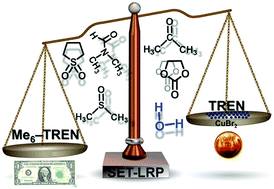SET-LRP mediated by TREN in biphasic water–organic solvent mixtures provides the most economical and efficient process
Abstract
Tris(2-aminoethyl)amine (TREN) has been used as a replacement for tris(dimethylaminoethyl)amine (Me6-TREN) in the non-activated Cu(0) wire catalyzed SET-LRP of methyl and n-butyl acrylates performed in biphasic-binary mixtures containing an aqueous solution of Cu(II)Br2 and a ligand with water miscible or water immiscible organic solvents containing a monomer and a polymer. Dipolar aprotic solvents (DMF, DMSO, NMP, DMAc and sulfolane), cyclic carbonates (ethylene carbonate and propylene carbonate), cyclic ethers (THF and dioxane), alcohols (methanol, ethanol, and isopropanol), acetone, acetonitrile and 2-butanone were used as water soluble solvents while hexane, anisole, toluene and ethyl acetate were used as water insoluble solvents. The chain end functionality of the resulting polymers is close to 100%. All reagents used in this process including the ligand, the Cu(0) wire catalyst, the solvent and Cu(II)Br2 are air insensitive, and can be recycled and reused. In addition, since TREN is 80 times less expensive than Me6-TREN and some of these solvents are the least expensive commercial solvents available, we expect that this methodology, which most probably is the most economical and efficient metal-catalyzed living radical polymerization, can be transplanted to a continuous process of interest for technological applications.



 Please wait while we load your content...
Please wait while we load your content...